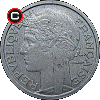2 francs FRANCE (1941-1959)


| diameter: | weight: | thickness: | alloy: |
| 27.0 mm | 2.2 g | 1.75 mm | Al |
obverse:
in the coin centre personification of France - Marianne's head in Phrygian cap and a wreath facing left; along the left edge: REPVBLIQVE, along the right one: FRANÇAISE (REPUBLIQUE FRANÇAISE - French Republic)
reverse:
in the coin centre in two lines face value: 2 / FRANCS; below year of issue; along the left and right edge two cornucopias; along the top edge in two lines motto of France: LIBERTE - EGALITE / FRATERNITE (liberty, equality, fraternity)
edge:
plain
issue date:
20 XII 1941
withdrawal date:
18 II 2002
designer:
Pierre-Alexandre Morlon (signature MORLON behind Marianne's head in the obverse)
mint:
 La Monnaie de Paris (The Paris Mint) (mint mark before year of issue in the reverse, after year of issue privy mark of mint's director Lucien Bazor - wing - in years 1941-1950 or Raymond Joly - owl - in years 1958-1959)
La Monnaie de Paris (The Paris Mint) (mint mark before year of issue in the reverse, after year of issue privy mark of mint's director Lucien Bazor - wing - in years 1941-1950 or Raymond Joly - owl - in years 1958-1959)
plant Paris (no letter between the bottoms of cornucopias in the reverse),
plant Beaumont-le-Roger (letter B between the bottoms of cornucopias in the reverse),
plant Castelsarrasin (letter C between the bottoms of cornucopias in the reverse)

mintage:
| Paris | Beaumont-le-Roger | Castelsarrasin | ||
| 1941 | ??? | - | - | wing |
| 1944 | 7 224 000 | - | - | wing |
| 1945 | 16 636 896 | 1 726 144 | 1 164 705 | wing |
| 1946 | 36 462 877 | 6 017 500 | - | wing |
| 1947 | 78 984 000 | 26 219 500 | - | wing |
| 1948 | 32 354 500 | 39 090 000 | - | wing |
| 1949 | 13 683 500 | 23 955 000 | - | wing |
| 1950 | 12 590 508 | 18 185 000 | - | wing |
| 1958 | 9 906 000 | - | - | owl |
| 1959 | 17 774 500 | - | - | owl |
varieties:
1945 - no letter (plant Paris), or letter B (plant Beaumont-le-Roger), or letter C (plant Castelsarrasin);
1946, 1947, 1948, 1949, 1950 - no letter (plant Paris) or letter B (plant Beaumont-le-Roger)
1946, 1947, 1948, 1949, 1950 - no letter (plant Paris) or letter B (plant Beaumont-le-Roger)
mint marks:
interesting facts:
last update: 20 XI 2013
coins catalogue :: katalog monet :: münzkatalog :: catalogue de monnaies :: catálogo de monedas :: catalogo monete :: каталог монет :: κέρματα κατάλογος :: COINZ.eu
© 2010-2025 :: Adam Kubicki :: COINZ.eu :: All rights reserved.


